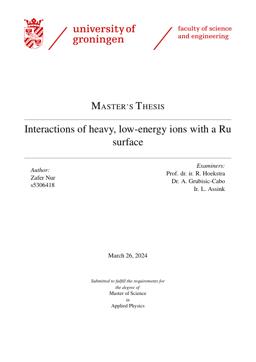2024-03-26
Interactions of heavy, low-energy ions with a Ru surface
Publication
Publication
The interactions between Xe ions in the keV-energy regime and a Ru surface have been studied. The light sources of the modern EUV lithography machines create Sn-ion debris, which may collide with EUV optics and damage them. Previous attempts to understand the interaction between a Sn ion beam and transition metal surfaces such as Mo and Ru, using the Binary Collision Approximation (BCA) have ended up with a discrepancy: the absence of a single collision peak in the scattering energy spectrum. The aim of this thesis is to test to what extent the BCA works for explaining ion surface interactions by using Xe, another element heavier than Ru, as a projectile, and to see whether this discrepancy is specific to Sn or if it is about being heavier than the target atoms. The experiments are conducted by hitting a surface with an ion beam obtained from an ECR ion source at the Zernike Low- Energy Ion Facility (ZERNIKELEIF) at the University of Groningen. As a result of the experiments, it has been observed that the intensities of all peaks decrease as the initial energy of the beams increases. The recoil peaks are dominant in the spectra for all beams with different energies. Another series of experiments has been performed with the same initial energy, but different initial charge states, and it shows that the initial charge state does not have a significant effect on the shape and overall counts of the resulting spectra. In conclusion, between the predictions of BCA and the experimental results, a fairly good match is found. However, the projectiles being heavier than the target atoms causes the recoil peak to be so intense that the SC peak appears to be hidden underneath the recoil peak
| Additional Metadata | |
|---|---|
| R. Hoekstra (Ronnie) | |
| University of Groningen | |
| Organisation | Ion Interactions |
|
Nur, Z. (2024, March 26). Interactions of heavy, low-energy ions with a Ru surface. |
|

